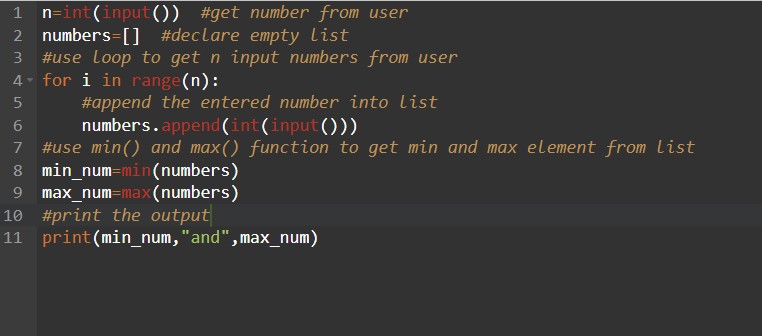4.20 LAB: Maximum and minimum Write a program that reads several integers one-by-one and then outputs the minimum and maximum integer. The program begins by prompting the user for the total number of integers that need to be read. Ex: If the input is: 65 5 -3 INNI 31 21 2 -6 O the output is: -6 and 21 Note that in this example, the first integer 6 refers to the total number of integers that will follow. You can assume that the sequence of integers will have at least 2 values. HINT: float('inf') is larger than every other float, and float('-inf') is smaller than any ever float. You may find these useful as variable initializers, when you are tracking minimum and maximum.
4.20 LAB: Maximum and minimum Write a program that reads several integers one-by-one and then outputs the minimum and maximum integer. The program begins by prompting the user for the total number of integers that need to be read. Ex: If the input is: 65 5 -3 INNI 31 21 2 -6 O the output is: -6 and 21 Note that in this example, the first integer 6 refers to the total number of integers that will follow. You can assume that the sequence of integers will have at least 2 values. HINT: float('inf') is larger than every other float, and float('-inf') is smaller than any ever float. You may find these useful as variable initializers, when you are tracking minimum and maximum.
Database System Concepts
7th Edition
ISBN:9780078022159
Author:Abraham Silberschatz Professor, Henry F. Korth, S. Sudarshan
Publisher:Abraham Silberschatz Professor, Henry F. Korth, S. Sudarshan
Chapter1: Introduction
Section: Chapter Questions
Problem 1PE
Related questions
Question
How to solve this question in python code

Transcribed Image Text:4.20 LAB: Maximum and minimum
Write a program that reads several integers one-by-one and then outputs the minimum and maximum integer. The program begins by
prompting the user for the total number of integers that need to be read.
Ex: If the input is:
6
5
-3
21
2
0
the output is:
-6 and 21
Note that in this example, the first integer 6 refers to the total number of integers that will follow. You can assume that the sequence of
integers will have at least 2 values.
HINT: float('inf') is larger than every other float, and float('-inf') is smaller than any ever float. You may find these useful as
variable initializers, when you are tracking minimum and maximum.
Expert Solution
Step 1
Code Screenshot:

Trending now
This is a popular solution!
Step by step
Solved in 3 steps with 2 images

Knowledge Booster
Learn more about
Need a deep-dive on the concept behind this application? Look no further. Learn more about this topic, computer-science and related others by exploring similar questions and additional content below.Recommended textbooks for you

Database System Concepts
Computer Science
ISBN:
9780078022159
Author:
Abraham Silberschatz Professor, Henry F. Korth, S. Sudarshan
Publisher:
McGraw-Hill Education

Starting Out with Python (4th Edition)
Computer Science
ISBN:
9780134444321
Author:
Tony Gaddis
Publisher:
PEARSON

Digital Fundamentals (11th Edition)
Computer Science
ISBN:
9780132737968
Author:
Thomas L. Floyd
Publisher:
PEARSON

Database System Concepts
Computer Science
ISBN:
9780078022159
Author:
Abraham Silberschatz Professor, Henry F. Korth, S. Sudarshan
Publisher:
McGraw-Hill Education

Starting Out with Python (4th Edition)
Computer Science
ISBN:
9780134444321
Author:
Tony Gaddis
Publisher:
PEARSON

Digital Fundamentals (11th Edition)
Computer Science
ISBN:
9780132737968
Author:
Thomas L. Floyd
Publisher:
PEARSON

C How to Program (8th Edition)
Computer Science
ISBN:
9780133976892
Author:
Paul J. Deitel, Harvey Deitel
Publisher:
PEARSON

Database Systems: Design, Implementation, & Manag…
Computer Science
ISBN:
9781337627900
Author:
Carlos Coronel, Steven Morris
Publisher:
Cengage Learning

Programmable Logic Controllers
Computer Science
ISBN:
9780073373843
Author:
Frank D. Petruzella
Publisher:
McGraw-Hill Education